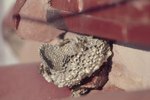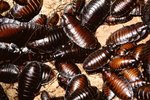
Bees may be perceived as annoying pests, but they are crucially beneficial to the environment, helping with pollination of plants that keep the world fed. Some colonizing bees are nonaggressive and easy for bee keepers to maintain. Bees have two varieties of social attitude -- colonizing and solitary.
Honeybees and Bumblebees
Honeybees live in large colonies of around 50,000 workers and produce great quantities of honey. Honeybees are not native to the United States; they traveled over from Europe with the first settlers. These bees are responsible for 80 percent of the pollination attributed to insects. Bumblebees live in smaller colonies, with just a few hundred workers, and produce small amounts of honey while protecting the queen bee as she lays eggs. Bumblebees get their name from the drone they produce in flight.
Sweat Bees
Sweat bees are unpopular bees due to their attraction to perspiration. These bees live in holes in the ground or in wood and create small colonies of a few queen bees who live together in separate cells within a single small nest. The nest has multiple entrances, each guarded by a bee. Sweat bees are attracted to the salty sweat from human skin, but they don't sting unless provoked -- and only females are capable of stinging.
Stingless Bees
Around 300 species of stingless bees or meliponines inhabit tropical and subtropical areas of the world. They get their name from having tiny stingers that are seldom used in defense. They build their colonies in hollow tree trunks and inside the crevices of large rocks, and are closely related to honeybees and bumblebees. Stingless bees also make honey and gather pollen like the stinging varieties of social bees.
Africanized Honeybees
Due to the fact that European honeybees didn't thrive well in the South American climates, scientists tried to blend the bloodlines of the African Honeybee with the European species. A few African honeybees escaped and have been breeding with and colonizing European honeybee sites ever since. These bees are extremely aggressive and attack in great numbers, without provocation. Africanized bees reproduce quickly and use all available resources as efficiently as possible before moving on to new territory.
Solitary Bees
Mason bees live in small families of one queen and a few males who breed with her, inside crevices in brick walls and rock piles. Leafcutter bees live inside hollow stems and tree bark. They also live as a family of a few males and a queen. Digger bees of the Apidae family often resemble colonizing bees because individual queens nest near each other in holes in the soil, but they raise larvae on their own.
References
- Innovateus: What Are the Different Types of Bees?
- Bee Pollen Health: Different Types of Bees
- Types of Bees Guide: The Different Types of Bees
- NC State University -- General Entomology: Social Bees
- Arizona-Sonora Desert Museum: Bees
- Desert USA -- Southwest Adventure, Living and Travel: Killer Bees -- Africanized Honey Bees
Photo Credits
-
Brand X Pictures/Stockbyte/Getty Images




